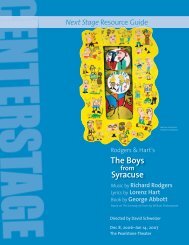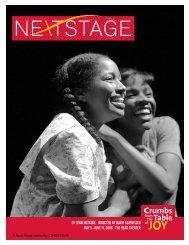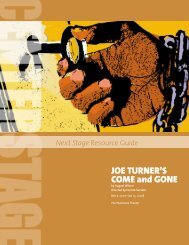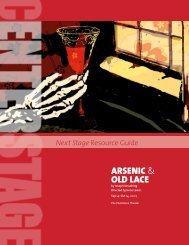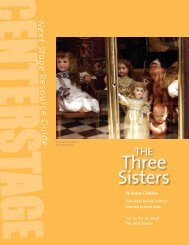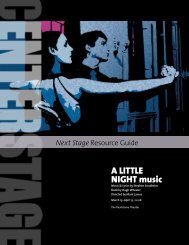The Matchmaker - Center Stage
The Matchmaker - Center Stage
The Matchmaker - Center Stage
You also want an ePaper? Increase the reach of your titles
YUMPU automatically turns print PDFs into web optimized ePapers that Google loves.
Or, 10 things you Didn’t Know you Knew About the Dutch In new york<br />
by Katie Van Winkle, Dramaturg Fellow<br />
1. It’s no accident that the Dutch names vandergelder and van<br />
Huysen roughly translate to “of the guilder” and “of the house.”<br />
Wilder writes Horace Vandergelder as a Dutch-American<br />
Pantalone, or Mr. Moneybags, while Flora Van Huysen’s house on<br />
8 Jackson Street, in today’s Lower East Side, looms large throughout<br />
the play: first as a threat of exile, finally as a space of protection<br />
and fulfillment. Her home could conceivably have been inhabited<br />
by her New Amsterdam ancestors as early as the 1640s.<br />
2. Wilder’s characters journey from yonkers but never leave old<br />
New Netherland. <strong>The</strong> land on which modern-day yonkers stands<br />
dates back to New York City’s pre-English colonial past. In 1646,<br />
Adriaen Van der Donck acquired the land, which soon came to be<br />
called “De Jonkheers”—meaning the estate of the young lord–<br />
which in turn eventually became Yonkers.<br />
3. the Battery’s name derives from the artillery batteries first<br />
stationed at the southern tip of the island of Manhattan in<br />
1683. In the 19 th Century, the street was a popular promenade<br />
with a spectacular view of the busy harbor. Wall Street, on the<br />
other hand, took its name from the literal wall that marked the<br />
northern boundary of the original Dutch settlement.<br />
4. <strong>The</strong> Dutch didn’t neglect the other boroughs: Brooklyn began as<br />
Breuckelen, a town chartered by the Dutch West India Company.<br />
Jonas Bronck, a Dutch sea captain, acquired 500 acres on the<br />
mainland between the Harlem and the Aquahung Rivers. <strong>The</strong><br />
latter came to be called “Bronck’s River,” or…the Bronx.<br />
5. Harlem, Coney Island, and the Bowery, like countless other<br />
nearby place names, hark back to old Holland. <strong>The</strong> Dutch city<br />
Haarlem lost an ‘a’ in the Atlantic Ocean; Conyne Eylandt was<br />
once overrun with rabbits (whose Dutch name conyne also yields<br />
“coney” in English slang); and the pear tree Peter Stuyvesant<br />
brought from Holland in 1647 and planted on his farm—or<br />
bouwerij—bore fruit until 1867.<br />
6. Cornelius vanderbilt, real-life contemporary of Horace<br />
Vandergelder and fellow self-made man, was a railroad and<br />
shipping magnate. Beginning life as the great-great-greatgrandson<br />
of an indentured servant from the Dutch village De<br />
Bilt, by the 1880s Vanderbilt had become the second-wealthiest<br />
American ever. Vandergelder, who enjoys a privileged status as<br />
the “first citizen of Yonkers,” is a small-town version of Vanderbilt<br />
and other Dutch-Anglo pillars of the community, such as the<br />
Stuyvesants, Roosevelts, van Rensselaers, van Burens, and van<br />
Cortlandts.<br />
7. Ice skates were designed by the Dutch. This winter exercise<br />
famously endures at the outdoor skating rink at Rockefeller <strong>Center</strong><br />
in Midtown Manhattan.<br />
8. <strong>The</strong> new york Knicks are named for Father Knickerbocker, a<br />
comic Washington Irving pen-name and character, the Dutch<br />
founder of New York’s first prominent family. Like the New York<br />
Mets, the Knicks’ orange, blue, and white uniforms are the official<br />
colors of New York City—and of the United Netherlands in the<br />
year 1625.<br />
9. Our slang term for splitting the bill at a restaurant no longer<br />
sounds like an ethnic slur, but 17 th -century English colonists, in the<br />
throes of the Anglo-Dutch Wars, spoke disparagingly of “Dutch<br />
courage,” “Dutch uncles,” and “Dutch wives.” “Going Dutch,” now<br />
associated with egalitarianism and feminism, began as an insult<br />
for a selfish, penny-pinching person—qualities native to Horace<br />
Vandergelder.<br />
10. Does Vandergelder remind you of your own boss? Even if you<br />
don’t have it as bad as Cornelius and Barnaby, you’ve got the<br />
Manhattan Dutch to thank (or blame) for the term, which derives<br />
from baas (overseer).<br />
Next <strong>Stage</strong>: <strong>The</strong> <strong>Matchmaker</strong> | 1



